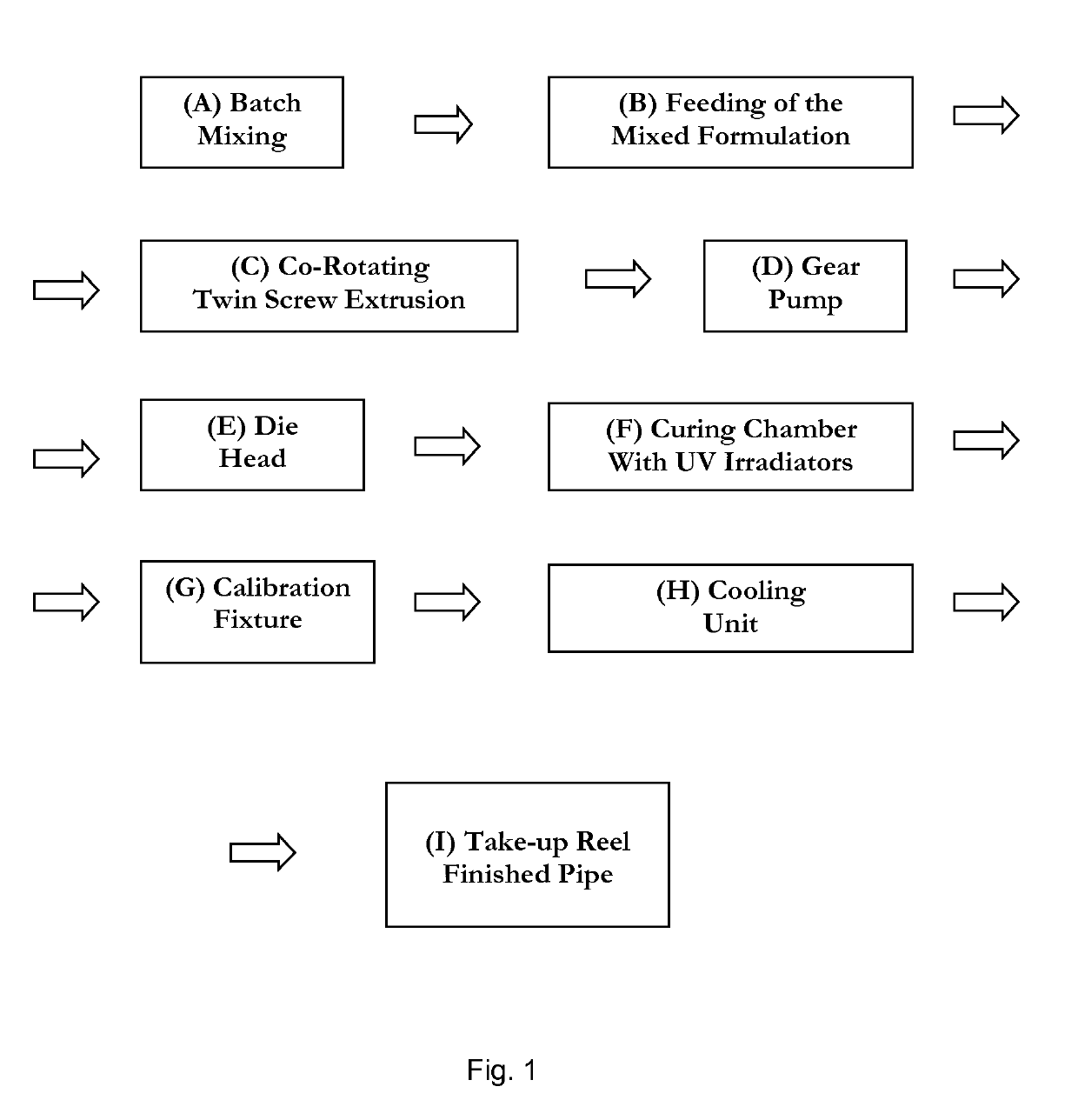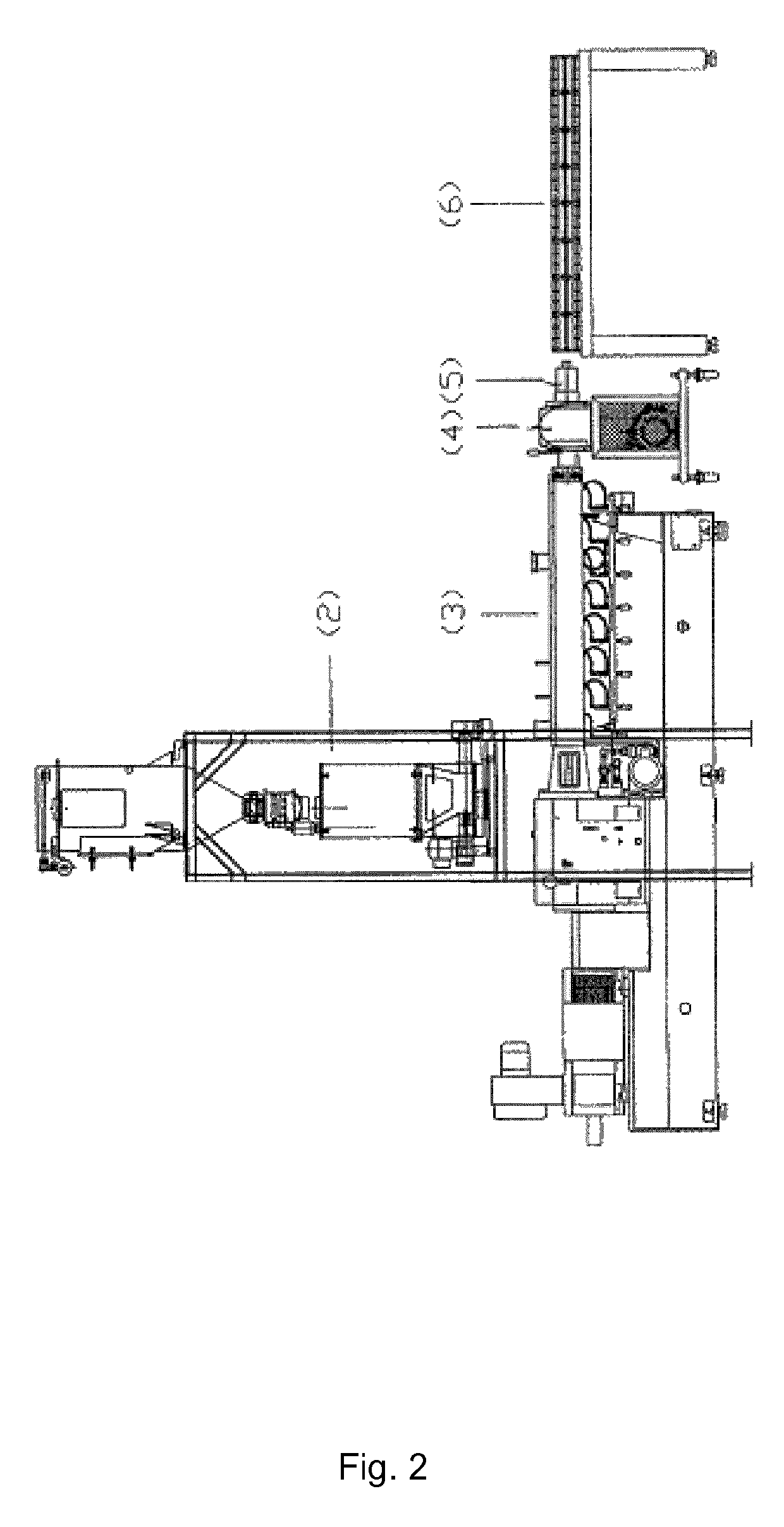Polyolefin pipe
a polyolefin and pipe technology, applied in the direction of pipes, pipes/joints/fittings, mechanical equipment, etc., can solve the problems of reducing the resistance of oxidative degradation, the difficulty of using plastic pipes in drinking water applications, and the potential problem of various additives, etc., to achieve excellent resistance to chlorine, reduce the level of leaching of chemical residuals, and increase the resistance to oxidative degradation
- Summary
- Abstract
- Description
- Claims
- Application Information
AI Technical Summary
Benefits of technology
Problems solved by technology
Method used
Image
Examples
example 1
jection
[0205]A trial was conducted to test the concept of direct injection of additives into the extruder. The set up included using a 27 mm twin screw extruder, a witte gear pump, and a spider-design die head to form ½″ tubing. The tubing was then crosslinked by exposure to UV irradiation. The HDPE base resin, along with processing aid, was added to the extruder via the extruder's feed throat entry point. For all other additives, a blend of 4 components (photoinitiator, co-agent, anti-oxidant, hindered amine light stabilizer), was premixed as a homogeneous liquid, which was directly injected into the extruder via an injection port in one of the upstream barrels. Direct injection into the extruder allowed for no pre-mixing of these components with HDPE resin and processing aid. Mixing of these 4 components with HDPE resin and processing aid occurred strictly from the mixing elements within the twin screw extruder.
[0206]An initial baseline experiment was performed, which involved pre...
example 2
of 4-Benzophenone Derivatives
[0211]The compound [4-(decyloxy)phenyl](phenyl)methanone was synthesised according to Reaction Scheme 1:
[0212]
[0213]The reaction conditions used to synthesize [4-(decyloxy)phenyl](phenyl)methanone comprised the following steps:[0214]1. 4-hydroxybenzophenone (125 g) and of acetone (500 mL) were added to a 1000 mL 3-neck round bottom flask.[0215]2. Potassium carbonate (50 g) followed by 1-bromodecane (175 mL), all at room temperature, were then added while stirring.[0216]3. A catalytic amount of 18-crown-6 (crown ether) was added.[0217]4. The reaction mixture was then refluxed for 48 hours, until at least 90% of the 4-hydroxybenzophenone was consumed (preferably 100%), which can be monitored by testing aliquots with GC or HPLC.
[0218]The product was then isolated using the following procedure:[0219]Use rotovap or equivalent to evaporate acetone leaving solid mixture containing potassium carbonate and reaction product.[0220]Under stirring, add 500 mL de-ioni...
example 3
-Substituted and 4,4′-Bis-Substituted Benzophenones
[0229]Formulation 1
[0230]
MeasuredSTELTACNSF 61:“4-Alkoxy-BP” =ND33“4-Alkoxy-BH” =ND33“4-Hydroxy-BP” =71010“4-Hydroxy-BH” =41010Benzene =455Photoinitator: 4-Decyloxybenzophenone (CAS #: 78392-97-9)Test: PE = MFI 6.5;“4-Decyloxy-BP” = 0.93%;Ricon 152 = 1.0%;Cyasorb 3853 = 0.15%;Irganox 1076 = 0.5%Mw = 338.49 g / molM.p. = 56° C.CCL = 76%; OKMet the NSF 61 requirement.
[0231]Formulation 2
[0232]
MeasuredSTELTACNSF 61:“4-Alkoxy-BP” =ND33“4-Alkoxy-BH” =ND33“4-Hydroxy-BP” =41010“4-Hydroxy-BH” =41010Benzene =455Photoinitator: 4-Octadecyloxybenzophenone (CAS #: 121191-25-1)Test: PE = MFI 6.5;“4-Octadecyloxy-BP” = 1.24%;Ricon 152 = 1.0%;Cyasorb 3853 = 0.15%;Irganox 1076 = 0.5%Mw = 450.71 g / molM.p. = 78° C.CCL = 77%; OKMet the NSF 61 requirement.
[0233]Formulation 3
[0234]
MeasuredSTELTACNSF 61:“4-Alkoxy-BP” =1133“4-Alkoxy-BH” =6433“4-Hydroxy-BP” =31010“4-Hydroxy-BH” =41010Benzene =55Photoinitator: 4-Hexyloxybenzophenone (CAS #: 33707-56-1)Test: PE =...
PUM
| Property | Measurement | Unit |
|---|---|---|
| degree of crosslinking | aaaaa | aaaaa |
| speeds | aaaaa | aaaaa |
| speeds | aaaaa | aaaaa |
Abstract
Description
Claims
Application Information
 Login to View More
Login to View More - R&D
- Intellectual Property
- Life Sciences
- Materials
- Tech Scout
- Unparalleled Data Quality
- Higher Quality Content
- 60% Fewer Hallucinations
Browse by: Latest US Patents, China's latest patents, Technical Efficacy Thesaurus, Application Domain, Technology Topic, Popular Technical Reports.
© 2025 PatSnap. All rights reserved.Legal|Privacy policy|Modern Slavery Act Transparency Statement|Sitemap|About US| Contact US: help@patsnap.com



